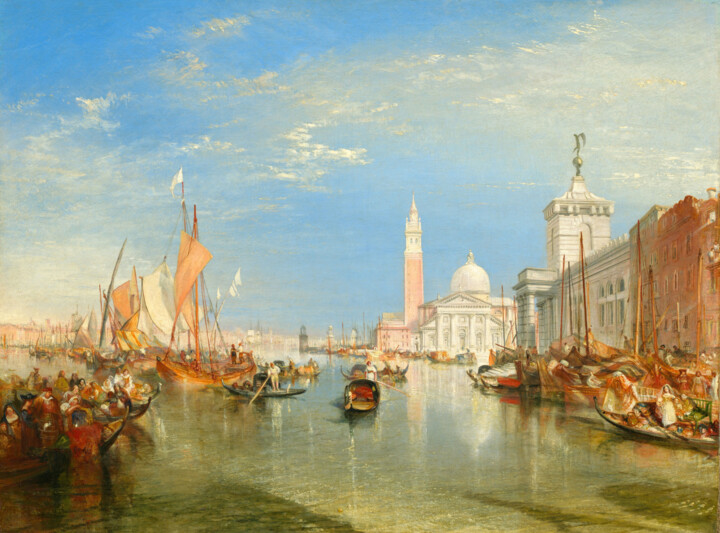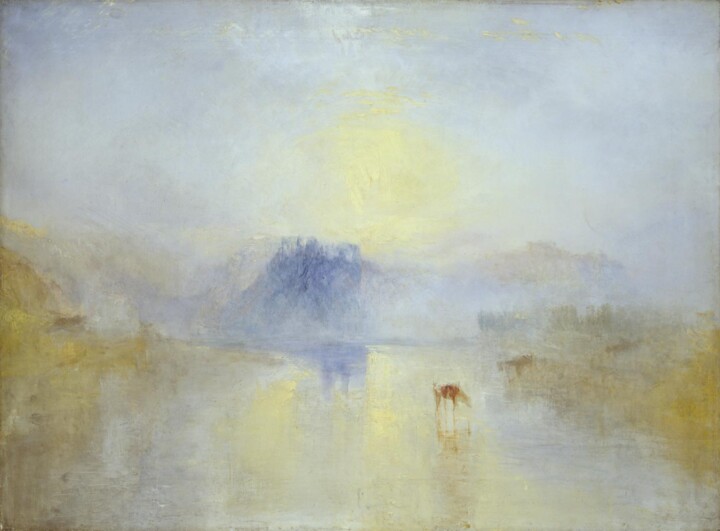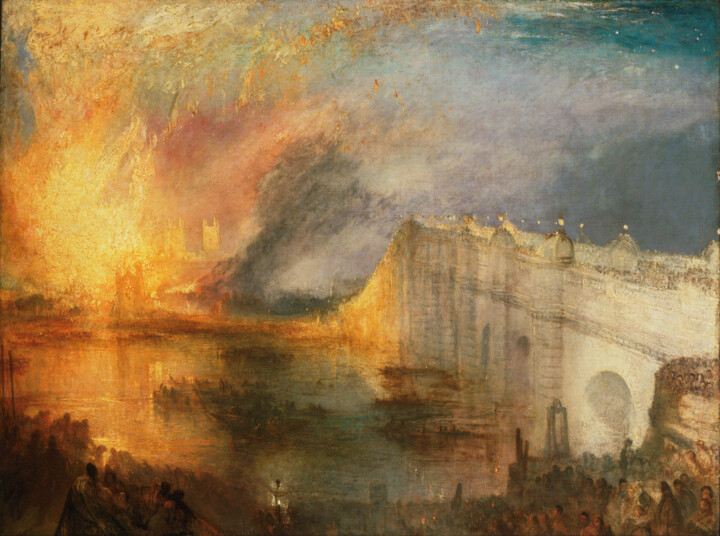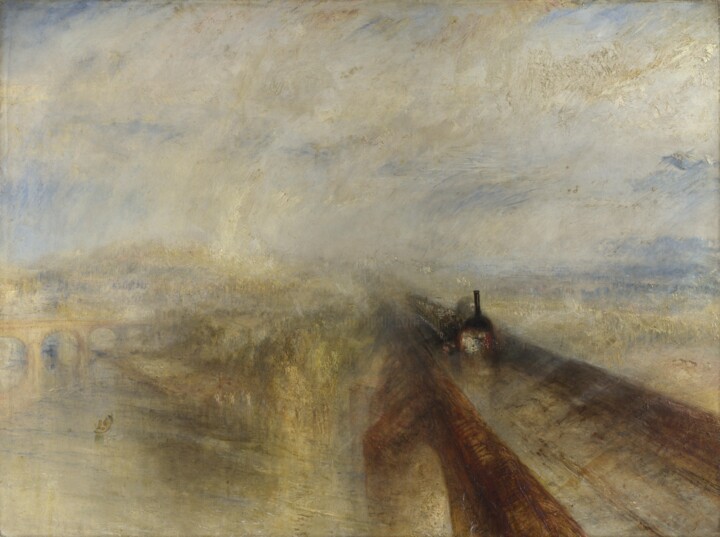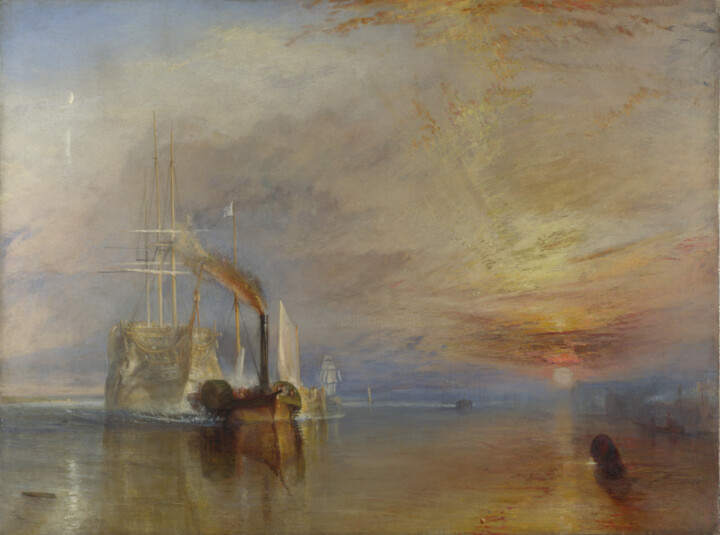 J. M. W. Turner - Self Portrait, 1799. Oil on canvas. 74.3 x 58.4 cm. Tate Gallery, London
J. M. W. Turner - Self Portrait, 1799. Oil on canvas. 74.3 x 58.4 cm. Tate Gallery, London
Who was J. M. W. Turner?
Joseph Mallord William Turner, known as William Turner, was an English painter, born on April 23, 1775, in London, England. He is considered one of the greatest artists of the Romantic era, known for his stunning landscapes and seascapes. Turner's work is characterized by his use of vibrant colors and dramatic, atmospheric effects.
Turner began his artistic career at a young age, studying at the Royal Academy of Arts in London. He quickly gained recognition for his talent, becoming a member of the Academy at just 26 years old. Over the course of his career, Turner produced over 550 oil paintings, 2,000 watercolors, and many drawings and sketches.
Some of Turner's most famous works include "The Fighting Temeraire," "Rain, Steam, and Speed," and "The Slave Ship." His paintings often portrayed the beauty and power of nature, while also commenting on contemporary issues such as industrialization and the slave trade.
Turner continued to work until his death on December 19, 1851, at the age of 76.
The Life and work of J. M. W. Turner
J. M. W. Turner was widely regarded as one of the greatest painters in British history. He began exhibiting his artwork at the Royal Academy of Arts when he was just 15 years old.
In his early career, Turner worked as an architectural draftsman, creating detailed drawings of buildings and landscapes for his clients. These early drawings and watercolors showcase his ability to capture the intricacies of light, shadow, and texture, and laid the groundwork for his later, more famous works. Turner's early work was heavily influenced by the Dutch landscape painters of the 17th century, but he soon developed his own unique style characterized by bold colors, loose brushwork, and innovative compositions. He was particularly interested in capturing light and atmospheric effects in his paintings, and he would often visit the locations he wanted to paint at different times of day to study the changing light conditions.
One of Turner's earliest known oil paintings is "Fishermen at Sea," completed in 1796 when he was only 21 years old. The painting depicts a group of fishermen struggling against the rough waves and turbulent sea, and is notable for its dramatic use of light and color to create a sense of movement and atmosphere.
Another notable early work by Turner is "Dolbadarn Castle," completed in 1800. The painting depicts the ruins of Dolbadarn Castle in Wales, and is notable for its detailed and accurate rendering of the castle's architecture and the surrounding landscape. The painting is also notable for its use of light and shadow to create a sense of depth and drama.
Throughout his early career, Turner continued to focus on landscape painting and became known for his ability to capture the beauty and power of the natural world. His early works laid the foundation for his later, more innovative works, and helped to establish him as one of the most important artists of the Romantic period.
 J. M. W. Turner - Modern Rome – Campo Vaccino, 1839. Oil on canvas. 91.8 x 122.6 cm. The Getty Center, Los Angeles, California
J. M. W. Turner - Modern Rome – Campo Vaccino, 1839. Oil on canvas. 91.8 x 122.6 cm. The Getty Center, Los Angeles, California
William Turner was also a key figure in the Romantic movement, which emphasized emotion, imagination, and individualism. His paintings helped to define the movement, and he influenced many other Romantic artists with his focus on the natural world and his innovative approach to painting. His artworks are known for their dramatic, atmospheric effects, which he achieved through his use of light, color, and composition.
He was a master of capturing the beauty and power of nature in his works. His paintings often depicted landscapes, seascapes, and weather phenomena, such as storms and sunsets. He was particularly interested in capturing the changing effects of light, such as the way the sun's rays create reflections on water or the way fog can obscure or enhance a scene.
In his later years, Turner's paintings became more abstract and less focused on realistic representation. This approach is particularly evident in his later watercolor paintings, which are characterized by their loose, fluid brushstrokes and vibrant, translucent colors. His use of color and light became even more experimental, and his works were often criticized for their perceived lack of clarity and form. However, these later works are now celebrated for their pioneering approach to color and composition, and their influence on the development of modern art.
In addition to his artistic work, Turner was also a philanthropist who donated many of his works to public institutions such as the National Gallery and the British Museum. He was a private person who was known for his eccentricities, and he died in 1851 at the age of 76.
Turner's work continues to be highly valued today, and his paintings have sold for millions of dollars at auction. In 2019, his painting "Ehrenbreitstein" sold for over $50 million. His paintings are exhibited in major museums and galleries around the world, and they remain hugely popular with art lovers and collectors alike.
J. M. W. Turner's legacy is that of a pioneering artist who pushed the boundaries of what was considered possible in painting. His innovative use of color, light, and composition helped to pave the way for modern art, and his focus on capturing the beauty and power of nature inspired generations of artists to come, including the Impressionists, who were inspired by his use of light and color, and the Abstract Expressionists, who were drawn to his experimental approach to form and composition.
The ten most famous paintings by William Turner
These paintings represent some of Turner's most iconic and celebrated works, showcasing his ability to capture the sublime power of nature, light, and atmosphere in his artworks.
"Fishermen at Sea", 1796
The painting is considered one of Turner's earliest and most influential works, showcasing his interest in the natural world and his ability to capture its wild and unpredictable beauty. It depicts a group of fishermen at night, struggling in their small boat against the tumultuous and stormy sea.
Turner's painting captures the raw power and danger of the sea, with dramatic waves crashing against the boat and threatening to engulf it. The fishermen are shown as tiny and vulnerable figures, struggling against the forces of nature in a scene of intense drama and emotion. The painting features a range of tones and hues, from the pale moonlight on the water to the deep blues and grays of the stormy sky.
 J. M. W. Turner - Fishermen at Sea, 1796. Oil on canvas. 91.4 x 122.2 cm. Tate Gallery, London
J. M. W. Turner - Fishermen at Sea, 1796. Oil on canvas. 91.4 x 122.2 cm. Tate Gallery, London
“The Fighting Temeraire”, 1839
The painting depicts the retired HMS Temeraire being towed up the River Thames by a steam tug to be broken up for scrap. The painting is widely regarded as one of Turner's greatest works and is an iconic image of the decline of the age of sail and the rise of steam power.
The painting is notable for its use of color and light to create a sense of drama and emotion. The glowing sunset in the background contrasts with the dark, shadowy figures of the tugboat and the Temeraire, which symbolizes the passing of an era. The painting was a reflection of Turner's own feelings about the decline of the Royal Navy, and it has been interpreted as a metaphor for the passage of time and the transience of all things.
"The Fighting Temeraire" is held in the collection of the National Gallery in London and is widely regarded as one of the most iconic paintings. It has been reproduced in countless forms, including on the reverse of the Bank of England's £20 note.
 J. M. W. Turner - The Fighting Temeraire, 1839. Oil on canvas. 90.7 x 121.6 cm. National Gallery London
J. M. W. Turner - The Fighting Temeraire, 1839. Oil on canvas. 90.7 x 121.6 cm. National Gallery London
“Rain, Steam, and Speed”, 1844
The painting depicts a locomotive rushing across a bridge over the River Thames during a rainstorm. The painting is notable for its innovative use of color, light, and composition, and is considered a masterpiece of British Romanticism.
The painting captures the energy and dynamism of the Industrial Revolution, which was transforming British society at the time. The locomotive is shown hurtling across the bridge at high speed, with smoke and steam billowing out behind it. The rain and mist create a sense of atmosphere and drama, and the painting is notable for its use of vibrant colors to create a sense of movement and intensity. The artwork has been interpreted as a celebration of the power of technology and the triumph of human ingenuity over the forces of nature.
"Rain, Steam, and Speed" is held in the collection of the National Gallery in London.
 J. M. W. Turner - Rain, Steam and Speed, 1844. Oil on canvas. 91 cm x 121.8 cm. National Gallery, London
J. M. W. Turner - Rain, Steam and Speed, 1844. Oil on canvas. 91 cm x 121.8 cm. National Gallery, London
“The Slave Ship”, 1840
The painting depicts a scene of cruelty and violence, as a slave ship is caught in a storm and jettisons its sick and dying slaves overboard in order to claim compensation from the ship's insurers. The painting is considered one of Turner's most powerful works and a condemnation of the cruelty of the slave trade.
The painting is notable for its use of color and light to create a sense of drama and horror. The red and orange hues of the sunset contrast with the dark, foreboding sea and the ghostly figures of the slaves drowning in the water. The painting has been interpreted as a protest against the horrors of the slave trade, which was still legal in Britain at the time the painting was created.
"The Slave Ship" is held in the collection of the Museum of Fine Arts in Boston and is celebrated for its powerful message and its innovative approach to painting, which helped to redefine the role of art in social and political commentary.
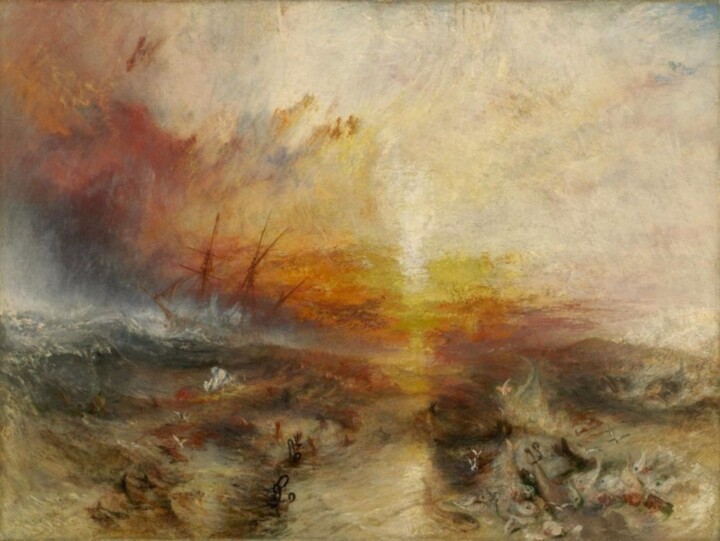 J. M. W. Turner - The Slave Ship, 1840. Oil on canvas. 90.8 x 122.6 cm. Museum of Fine Arts Boston
J. M. W. Turner - The Slave Ship, 1840. Oil on canvas. 90.8 x 122.6 cm. Museum of Fine Arts Boston
“Snow Storm: Steam-Boat off a Harbour's Mouth”, 1842
The painting depicts a steamboat struggling to navigate through a snowstorm near the entrance to a harbor, with waves crashing over the ship and creating a sense of chaos and danger.
The painting is notable for its use of color, light, and texture to create a sense of movement and atmosphere. The swirling snow, mist, and waves combine to create a sense of turbulence and confusion, and the painting is notable for its innovative use of texture to create a sense of movement and intensity.
"Snow Storm: Steam-Boat off a Harbour's Mouth" is held in the collection of Tate Britain in London. It has been interpreted as a metaphor for the fragility of human life in the face of the vast and unpredictable forces of nature.
 J. M. W. Turner - Snow Storm - Steam-Boat off a Harbour's Mouth, 1842. Oil on canvas. 91 x 122 cm. Tate Britain
J. M. W. Turner - Snow Storm - Steam-Boat off a Harbour's Mouth, 1842. Oil on canvas. 91 x 122 cm. Tate Britain
“Norham Castle, Sunrise”, 1845
The painting depicts the ruins of Norham Castle, located on the border between England and Scotland, at sunrise. The painting is notable for its use of light, color, and atmosphere to create a sense of peace and tranquility.
The painting captures the beauty and majesty of the English countryside, with the castle ruins set against a glowing orange and yellow sky. The river Tweed flows peacefully in the foreground, and the painting is notable for its delicate use of color to create a sense of harmony and balance.
"Norham Castle, Sunrise" is held in the collection of the Tate Britain in London.
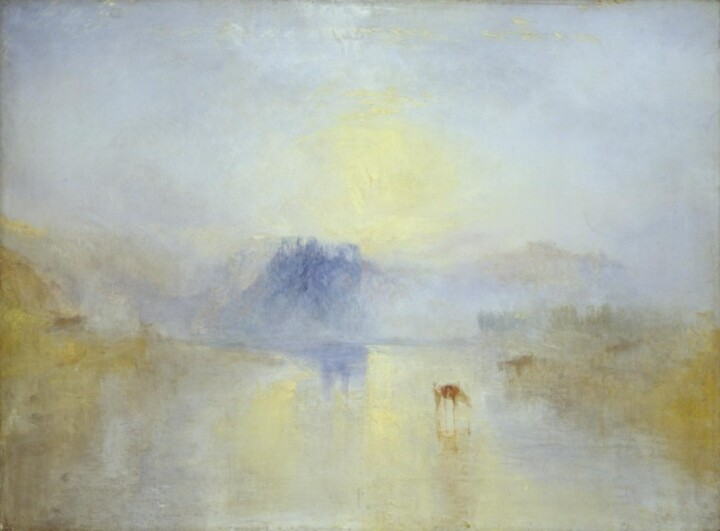 J. M. W. Turner - Norham Castle, Sunrise, 1845. Oil on canvas. 91 x 122 cm. Tate Britain
J. M. W. Turner - Norham Castle, Sunrise, 1845. Oil on canvas. 91 x 122 cm. Tate Britain
"Snow Storm: Hannibal and his Army Crossing the Alps", 1812
The artwork depicts the historical event of Hannibal Barca leading his army of Carthaginians, Gauls, and elephants across the treacherous and snowy Alpine mountains in 218 BC during the Second Punic War.
Turner's painting captures the harshness and brutality of the journey, with swirling snow, dark clouds, and a sense of ominous danger. The painting features a group of soldiers and elephants struggling through the storm, with some falling off cliffs or being trampled by their own companions. The scene is rendered in vivid colors and dramatic brushstrokes, conveying the monumental nature of the historical event and the intense emotions of the characters.
The painting is considered one of Turner's most famous works, showcasing his ability to capture the sublime power of nature and the human struggle against it. It is part of the collection of the Tate Britain in London.
 J. M. W. Turner - Snow Storm: Hannibal and his Army Crossing the Alps, 1812. Oil on canvas. 144.7x 236 cm. Tate Britain
J. M. W. Turner - Snow Storm: Hannibal and his Army Crossing the Alps, 1812. Oil on canvas. 144.7x 236 cm. Tate Britain
"The Evening of the Deluge", 1843
The painting depicts a chaotic scene of destruction as a great flood overtakes a city. The buildings in the foreground are being swept away by the rushing water, while figures struggle to escape the rising tide.
The sky above the city is a swirling mass of dark clouds and smoke, adding to the sense of impending doom. In the distance, a ship can be seen battling the stormy sea, adding to the sense of danger and chaos.
Despite the destruction, there is also a sense of beauty in the painting. Turner's use of color and light creates a dramatic and breathtaking scene, even amidst the chaos. The golden light in the sky contrasts with the darkness of the storm, and the reflections in the water add depth and movement to the painting. "The Evening of the Deluge" is a powerful work of art that captures the raw power of nature and the fragility of humanity in the face of disaster.
 J. M. W. Turner - The Evening of the Deluge, 1843. Oil on canvas. 76 x 76 cm. National Gallery of Art, Washington, D.C., United States
J. M. W. Turner - The Evening of the Deluge, 1843. Oil on canvas. 76 x 76 cm. National Gallery of Art, Washington, D.C., United States
"Venice - The Dogana and San Giorgio Maggiore", 1834
The painting depicts the city of Venice, with the Dogana (customs house) in the foreground and the church of San Giorgio Maggiore in the background.
The painting is known for its use of light and color, with Turner capturing the shimmering waters of the Venetian lagoon and the bright light of the setting sun. The warm colors of the sky and the reflections in the water create a sense of tranquility and calmness, while the architectural details of the buildings add a sense of grandeur and history.
Turner was known for his romantic style, and "Venice - The Dogana and San Giorgio Maggiore" is a prime example of this. The painting is not a strict representation of the city, but rather a romanticized interpretation that captures the essence of Venice and its unique atmosphere.
 J. M. W. Turner - Venice - The Dogana and San Giorgio Maggiore, 1834. Oil on canvas. 91.5 x 122 cm. National Gallery of Art, Washington, D.C., USA
J. M. W. Turner - Venice - The Dogana and San Giorgio Maggiore, 1834. Oil on canvas. 91.5 x 122 cm. National Gallery of Art, Washington, D.C., USA
"Dido Building Carthage, or The Rise of the Carthaginian Empire", 1815
The painting depicts the legendary founding of Carthage by the Phoenician queen Dido, as she supervises the construction of the city's walls and buildings.
Turner's painting captures the grandeur and majesty of the ancient world, with rich colors and intricate details that convey the complexity and beauty of the scene. The painting features a range of architectural styles, from classical to Eastern, and showcases the cultural diversity and sophistication of the ancient world. The figures are shown as idealized and heroic, with Dido herself portrayed as a powerful and commanding figure.
The painting is considered one of Turner's most accomplished and innovative works, showcasing his ability to combine history, myth, and imagination in a single composition.
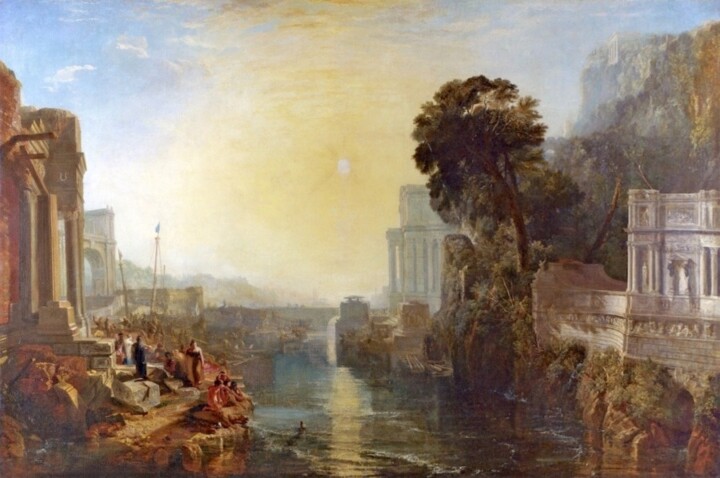 J. M. W. Turner - Dido Building Carthage or The Rise of the Carthaginian Empire, 1815. Oil on canvas. 155.5 x 230 cm. National Gallery, London
J. M. W. Turner - Dido Building Carthage or The Rise of the Carthaginian Empire, 1815. Oil on canvas. 155.5 x 230 cm. National Gallery, London
Legacy
William Turner was known for his influential and innovative work in landscape painting. His legacy is multifaceted and enduring, encompassing both his technical innovations and his impact on the development of art in general.
He was known for his experimental approach to painting, which included the use of bold colors, loose brushwork, and unconventional compositions. His innovative techniques helped to pave the way for modern art and inspired later artists to experiment with new approaches to painting.
Turner was a master of light, color, and atmosphere, and his paintings often capture the sublime and dramatic power of nature. His focus on the natural world inspired later artists to explore similar themes in their own work. He was also a pioneer of the Romantic movement, which emphasized emotion and imagination over reason and tradition, and his work helped to pave the way for modernism. Turner was definitely a key figure in the Romantic movement, which emphasized emotion, imagination, and individualism. His paintings helped to define the movement and influenced other Romantic artists, including Caspar David Friedrich and John Constable.
In addition to his artistic contributions, Turner was also a dedicated teacher and mentor to younger artists. He was a founding member of the Royal Academy of Arts, and he played an instrumental role in shaping the direction of British art in the 19th century. His legacy can be seen in the work of many later British artists, including the Pre-Raphaelites.


 Selena Mattei
Selena Mattei

